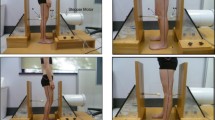Abstract
The first aim is to show if there is a disorder in proprioception in cases with benign joint hypermobility syndrome (BJHS) when compared to healthy subjects. The second aim is to evaluate the effect of proprioception exercise in BJHS cases. To evaluate the proprioceptive sensibility of the knee joint with 40 BJHS and 30 healthy subjects enrolled in the study. Then, cases with BJHS were randomized into two groups; proprioceptive exercises were applied to 15 patients for 8 weeks in clinic and 25 patients were taken as controls. Outcome measures included proprioceptive sensation, AIMS2 and VAS. Proprioception is significantly impaired in cases with BJHS. In BJHS group, significant decreases in VAS levels were detected in cases who did exercise compared with cases who did not, and statistically significant improvements were detected in occupational activity. For this reason proprioception exercises cause decrease in pain and improvement of functional status in BJHS group.
Similar content being viewed by others
References
Keer R, Grahame R (2003) Hypermobility syndrome: recognition and management for physiotherapists. Butterworth-Heinemann, Edinburg, New York
Everman DB, Robin NH (1998) Hypermobility syndrome. Pediatr Rev 19:111–117
Russek LN (1999) Hypermobility syndrome. Phys Ther 79:591–599
Silverman S, Constine L, Harvey W (1975) Survey of joint mobility and in vivo skin elasticity in London schoolchildren. Ann Rheum Dis 34:177–180
Grahame R, Brid H, Child A (2000) The revised (Brighton 1998) criteria for the diagnosis of benign joint hypermobility syndrome. J Rheumatol 27:1777–1779
Sharma L (1999) Proprioceptive impairment in knee osteoarthritis. Rheum Dis Clin North Am 25:299–314
Mallik AK, Ferrell WR, McDonald AG, Sturrock RD (1994) Impaired proprioceptive acuity at the proximal interphalangeal joint in patients with the hypermobility syndrome. Br J Rheumatol 33:631–637
Jerosch J, Prymka M (1996) Proprioception and joint stability. Knee Surg Sports Traumatol Arthrosc 4:171–179
Sharma L, Pai YC (1997) Impaired proprioception and osteoarthritis. Curr Opin Rheumatol 9:253–258
Hall C, Brody LT (1999) Impairment of muscle performance. In: Hall CM, Brody LT (eds) Therapeutic exercise moving toward function. Williams and Wilkins, Philadelphia, pp 59–60
Barton LM, Bird HA (1996) Improving pain by the stabilization of hyperlax joints. J Orthop Rheumatol 9:46–51
Lephard SM, Fu FH (2000) Proprioception and neuromuscular control in joint stability. Human Kinetics, Pittsburg
Fischer-Rasmussen T, Jensen PE (2000) Proprioceptive sensitivity and performance in anterior cruciate ligament deficient knee joints. Scand J Med Sci Sports 10:85–89
Hall GM, Ferrel WR, Sturrock RD (1995) The effect of the hypermobility syndrome on knee joint proprioception. Br J Rheumatol 34:121–125
Petrella RJ, Lattanzio PJ, Nelson MG (1997) Effect of age and activity on knee joint proprioception. Am J Phys Med Rehabil 76:235–241
Marks R, Quinney HA, Wessel J (1993) Proprioceptive sensibility in women with normal and osteoarthritic knee joints. Clin Rheumatol 12:170–175
Lattanzio PJ, Petrella RJ, Sproule JR, Fowler PJ (1997) Effects of fatigue knee proprioception. Clin J Sport Med 7:22–27
Atamaz F, Hepgüler S, Öncü J (2004) AIMS 2 (Romatizma Ölçüm Skalası-2) Türk versiyonunun geçerlilik ve güvenilirlik çalışması. Romatizma Acta Rheumatologica Turcica 19(suppl 1):15
Meenan RF, Mason JH, Anderson JJ, Guccione AA, Kazis LE (1992) The content and properties of a revised and expanded Arthritis Impact Measurement Scales Health Status Questionnaire. Arthritis Rheum 35:1–10
Diracoglu D, Aydin R, Baskent A, Celik A (2005) Effects of kinesthesia and balance exercise in knee osteoarthritis. J Clin Rheumatol 11:303–310
Brotzman SB (1996) Clinical orthopaedic rehabilitation. Mosby, Philadelphia
Hakim A, Grahame R (2003) Joint hypermobility. Best Pract Res Clin Rheumatol 17:989–1004
Barrack RL, Skinner HB, Buckley SL (1989) Proprioception in the anterior cruciate deficient knee. Am J Sports Med 17:1–6
Ferrell WR, Tennant N, Sturrock RD, Ashton L, Creed G, Brydson G, Rafferty D (2004) Amelioration of symptoms by enhancement of proprioception in patients with joint hypermobility syndrome. Arthritis Rheum 50:3323–3328
Grahame R (2000) Heritable disorders of connective tissue. Baillieres Best Pract Res Clin Rheumatol 14:345–361
Roberts D, Friden T, Stomberg A, Lindstrand A, Moritz U (2000) Bilateral proprioceptive defects in patients with a unilateral anterior cruciate ligament reconstruction: a comparison between patients and healthy individuals. J Orthop Res 18:565–571
Jacoby SM (2001) Isokinetics in rehabilitation. In: Prentice WE, Voigth ML (eds) Techniques in musculoskeletal rehabilitation. McGraw-Hill, New York, pp 154–160
Topp R, Woolley S, Hornyak J (2002) The effect of dynamic versus isometric resistance training on pain and functioning among adults with osteoarthritis of the knee. Arch Phys Med Rehabil 83:1187–1195
Author information
Authors and Affiliations
Corresponding author
Rights and permissions
About this article
Cite this article
Sahin, N., Baskent, A., Cakmak, A. et al. Evaluation of knee proprioception and effects of proprioception exercise in patients with benign joint hypermobility syndrome. Rheumatol Int 28, 995–1000 (2008). https://doi.org/10.1007/s00296-008-0566-z
Received:
Accepted:
Published:
Issue Date:
DOI: https://doi.org/10.1007/s00296-008-0566-z




